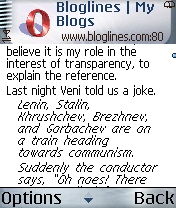Graphic Design
Muji Chronotebook is a new dayplanner that uses an analog “clock” metaphor, with each page arranged around a circular center. The left page is AM and the right page is PM.

So, my first reaction was really positive. We desperately need more design that grounds our daily experience in the physical, and this appears to be beautifully expressive of circadian rhythms and the subjective experience of time, but…
… is it really so natural? Looking at the layout, I feel pretty uncomfortable. Sure, our experience of a sequence of days is cyclical, but I think our experience of the flow of a single day is much more linear.
I also wonder about writing around a circle. Maybe this works better for character-based languages, but it seems awkward for, say, english.
(Please note that I haven’t actually used the thing. Maybe it’s awesome ;)
This will surely come in handy: Blasting the Myth of the Fold.
I was checking out exactitudes (well worth the click if you haven’t seen it before) and, stumbling around google, found a hidden pdf from some class on typologies: check it out (though you’ve probably seen many of the photos before).
Remember how you stopped using italics because they looked so bad on web pages, but then when the operating systems started anti-aliasing you started using them again? Well, think again, my friend. They’re worse than ever on the small screen:

Dear web 2.0 design community: Please stop using so many gradients.
Thanks,
Nadav.
Kottke linked to flickr photos tagged “comic sans” and I was thinking it’d be interesting to see the geographic distribution of something like that. Unfortunately mappr is US-only and only one photo showed up, which, I assure you, doesn’t indicate any US superiority in typeface usage.
I had no idea that Air Conditioning was so critical to the history of printing. That’s cool.
A collection of instructions and art from late-midcentury Monster Model kits. (via)
Dirt Style 101 is a now-outdated response to the apparently not-quite-slick enough (to escape satire) web design of 2002.
